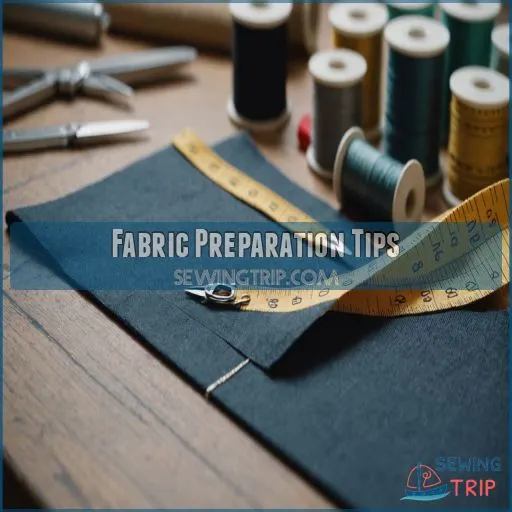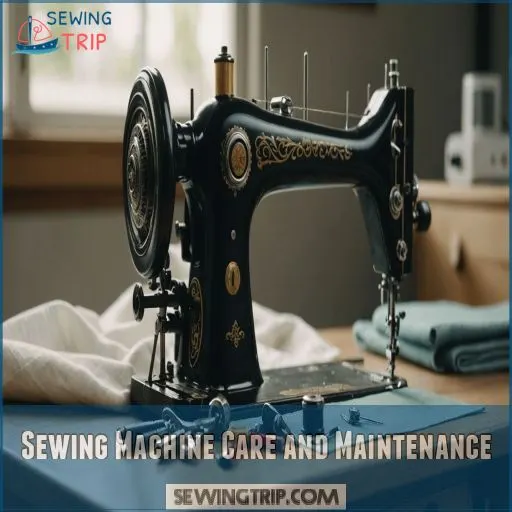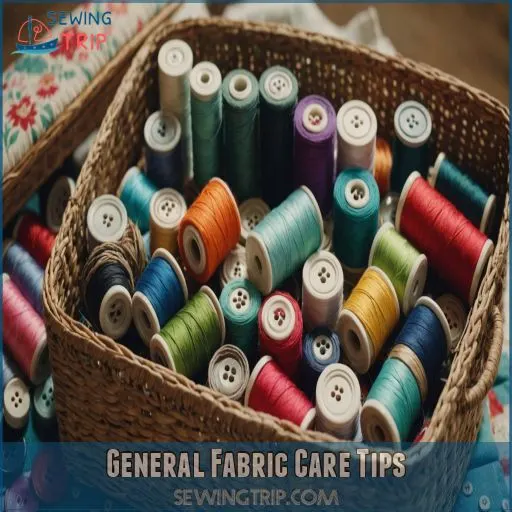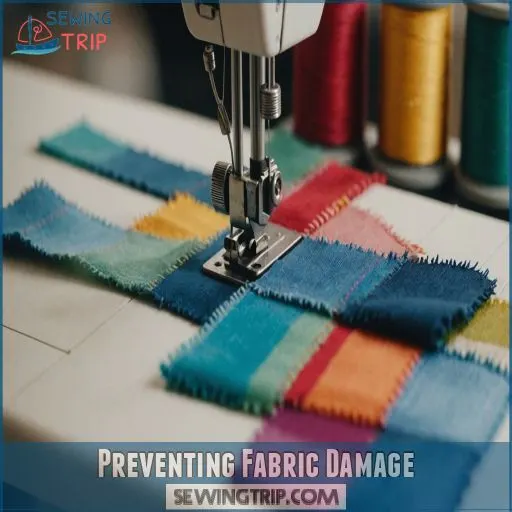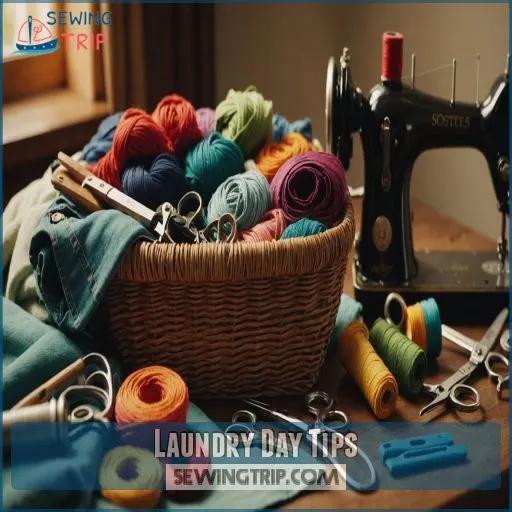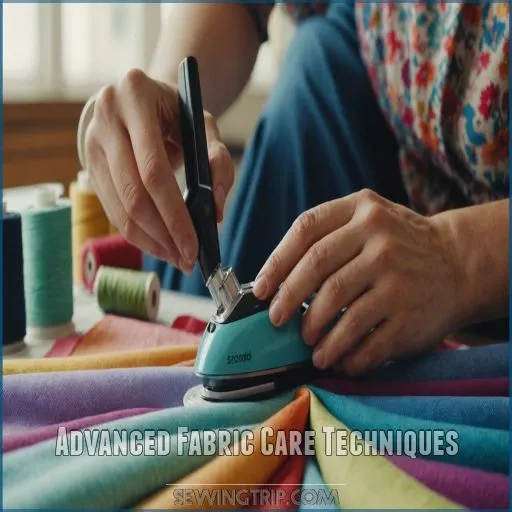This site is supported by our readers. We may earn a commission, at no cost to you, if you purchase through links.
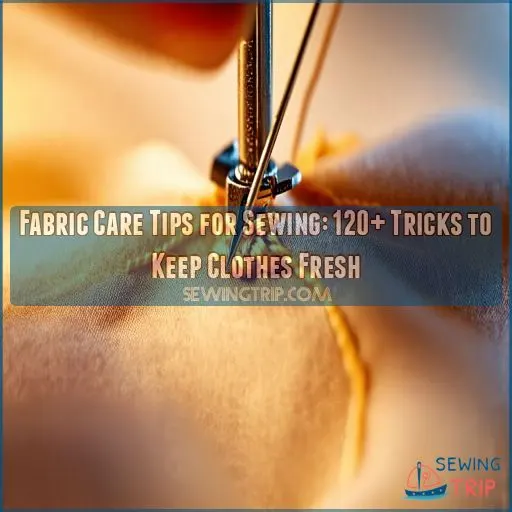
Start with pre-washing your fabrics to avoid any surprise shrinkage or color drama later.
When prepping fabric for sewing, remove wrinkles with a good steamer or low-heat iron, but don’t forget the trusty pressing cloth to keep things looking sharp.
Your sewing machine deserves love too; keep it lint-free and oiled for smooth stitching.
Launder gently—cold water works wonders for delicate pieces.
Remember, mastering these fabric care tips for sewing turns your creations into professional-looking masterpieces.
Curious about more expert insights? Keep reading!
Table Of Contents
- Key Takeaways
- Fabric Preparation Tips
- Sewing Machine Care and Maintenance
- General Fabric Care Tips
- Caring for Delicate Fabrics
- Preventing Fabric Damage
- Fabric Specific Care Instructions
- Stain Removal and Fabric Repair
- Laundry Day Tips
- Storing and Organizing Fabrics
- Advanced Fabric Care Techniques
- Frequently Asked Questions (FAQs)
- Conclusion
Key Takeaways
- Pre-wash your fabric to prevent shrinkage and color bleeding, ensuring your projects fit perfectly and retain their colors.
- Regularly brush the machine after each use to remove surface lint as part of a sewing machine cleaning guide. Regularly clean and oil your sewing machine to keep it running smoothly and avoid frustrating thread jams and tension problems.
- Use steamers and pressing cloths to remove wrinkles and protect delicate fabrics during ironing, keeping your creations looking polished.
- Handle delicate fabrics like silk and velvet with care; use gentle washing techniques and store them properly to prevent damage and maintain their quality.
Fabric Preparation Tips
Preparing your fabric before sewing is like warming up before a workout—you wouldn’t skip it, right?
Pre-washing your fabric is essential, as it can shrink or bleed during the washing process.
Mastering the art of wrinkle-busting ironing will help your projects come out looking polished and professional.
Pre-Washing Fabrics for Sewing
Before sewing, tackle fabric shrinkage and color bleeding by pre-washing your fabrics.
It’s your secret weapon for perfect fits!
Just imagine sewing a shirt, only to find it shrinks to toddler size—yikes!
Follow washing instructions, matching techniques to fabric types.
You’ll banish excess dye and chemicals, ensuring your creations stay vibrant and true to size.
Removing Wrinkles and Creases
Got a wrinkle mess? Use these tips for smooth sailing!
With fabric care tips for sewing, you can master wrinkle prevention and crease busting like a pro.
- Steam it out: Hang with a steamer for gentle de-wrinkling.
- Pressing cloth: Protect delicate fabrics during ironing.
- Proper storage: Fold or hang to minimize creases.
- Cooling trick: Dry on low to reduce fold marks.
Ironing Techniques for Fabric Preparation
Now that your fabrics are wrinkle-free, let’s talk ironing techniques.
Set the ironing temperature based on fabric types: cooler for wool, hotter for cotton.
Use steam settings wisely—don’t turn your fabric into a sauna!
A pressing cloth prevents shine on delicate areas.
Master these fabric care steps, and your sewing projects will look sharp and professional (Source).
Sewing Machine Care and Maintenance
Keeping your sewing machine in top shape is like giving it a spa day—it deserves regular cleaning, a bit of oil, and some attention to common hiccups.
You’ll be surprised how these simple steps can prevent those frustrating thread jams and tension issues, allowing you to sew smoothly and stress-free.
Cleaning The Sewing Machine
You’ve washed fabrics perfectly, and it’s time to care for your sewing machine.
Keep it running smoothly with regular cleaning.
Follow these steps:
- Unplug and Remove Thread: Safety first!
- Dust and Lint Removal: Use a brush or a pipe cleaner to clear out debris.
- Check Bobbin Case: Make sure no tangled thread remains.
Happy sewing!
Oiling The Sewing Machine
To keep your sewing machine running smoothly, be sure to oil it regularly.
Use a high-quality sewing machine oil, such as Lily White or Singer Machine Oil, which are low-viscosity mineral oils that won’t stain your fabrics.
Apply a few drops to the moving parts, like the needle bar and feed dogs, every few hours of use.
| Oil Type | Oiling Frequency | Oiling Tools |
|---|---|---|
| Sewing Machine Oil | Every 4-8 hours of use | Oiling Pot or Syringe |
| Synthetic Oil Blend | Every 8-12 hours of use | Oiling Pot or Syringe |
| Mineral Oil | Every 2-4 hours of use | Oiling Pot or Syringe |
Troubleshooting Common Sewing Machine Issues
After oiling your sewing machine, it’s maddening when needle problems or bobbin tension issues still cause frustration.
Fight back against skipped stitches and thread jams by checking if your needle’s bent or inserted wrong.
If your sewing resists despite adjustments, clean pesky lint from your bobbin case regularly—dust bunnies simply love causing chaos in your creations! (Source)
General Fabric Care Tips
Taking care of your fabrics is like feeding a picky houseplant—get it right, and you’ll keep everything looking fresh and fabulous.
From washing and drying to ironing and storing, these practical tips will help your clothes last longer and stay vibrant, even if they don’t quite manage to water themselves!
Washing and Drying Fabrics
When washing fabrics, choose the right laundry detergent and handle stains quickly.
Use cold water for delicate colors, especially for hand washing viscose.
Add a dash of fabric softener for extra softness.
For drying, avoid high heat settings and opt for hanging clothes or low-heat tumble drying to preserve fibers.
Not all fabrics need sunlight—shade is your best friend for vibrant colors!
Ironing and Steaming Fabrics
A good ironing session can transform your garments.
Use these tips and feel like a pro:
- Select the right iron—nothing beats a steam iron for wrinkle removal and versatility.
- Adjust heat settings based on fabric types; avoid crispy mishaps.
- Use pressing cloths and boards as essential ironing tools to keep fabrics pristine.
Storing Fabrics to Prevent Damage
Imagine this: Your fabrics neatly folded, living in perfect harmony with storage containers.
For moth prevention, toss in lavender sachets and rotate fabrics regularly.
Control humidity to avoid mildew, so your precious cloth doesn’t become a science experiment.
Proper folding prevents creases that could rival a crinkled map.
Happy crafting, and may your threads always be tangle-free!
Caring for Delicate Fabrics
When dealing with delicate fabrics like silk, rayon, and velvet, you’ve got to handle them like precious treasures, avoiding any rough maneuvers.
Think of it as babysitting the royal family of your wardrobe — a gentle touch and a little patience go a long way!
Silk Fabric Care
Silk is a delicate fabric that requires extra care.
Start by hand-washing in cool water with a mild detergent.
Avoid wringing or twisting, which can damage the fibers.
Lay flat to air dry, and iron on a low setting if needed.
Store silk items in a cool, dark place to prevent fading.
- Silk dyes beautifully with acid dyes
- Silk scarves can be dyed using silk ties
- Silk wedding dresses can be dyed at home
- Silk chiffon and organza have unique dyeing requirements
Rayon Fabric Care
Caring for rayon fabric requires attention to avoid mishaps.
To prevent rayon fibers from becoming damaged and prone to rayon shrinkage, understanding how to care for rayon is key, always wash in cold water using a gentle cycle or hand wash, if preferred.
For drying, air drying is your best bet; avoid high heat which can distort the shape.
In regard to rayon ironing, use low heat, and a pressing cloth works wonders.
Velvet Fabric Care
Velvet demands special attention, like a diva!
When working with velvet, understanding its direction of the nap is key to prevent fraying and achieve a professional finish.
For velvet storage, keep it flat to avoid creases, and never hang it.
When velvet cleaning, use gentle methods—hand wash or dry clean.
Skip the iron, as it flattens the pile; instead, try velvet steaming to smooth wrinkles.
Synthetic Fabric Care
While that luxurious velvet jacket demands careful care, synthetic fabrics like polyester bring their own quirks.
Their stain resistance is a plus, but when machine washing, use cold water to protect synthetic fabric properties.
Skip the dryer to prevent mishaps—microfibers aren’t best friends with heat!
For ironing tips, use a low setting to avoid any melty disasters.
Preventing Fabric Damage
You don’t want your favorite clothes to end up looking like they’ve survived a wrestling match with a porcupine, do you?
By avoiding overexposure to sunlight, preventing wrinkles, and keeping lint and pet hair at bay, you can keep your garments looking sharp and ready for anything.
Avoiding Overexposure to Sunlight
Switching from caring for delicate fabrics, let’s tackle sun exposure.
It’s like sunbathing—too much, and your clothes might suffer.
Here’s how to protect them:
- Use UV protection spray for a shielding barrier.
- Rotate garments regularly to even out exposure.
- Choose synthetic blends that resist fading.
- Add window film to block UV rays.
Preventing Wrinkles and Creases
Keeping wrinkles at bay in your fabrics is like winning a small daily battle.
Use proper fabric storage, folding methods, and ironing techniques to prevent those pesky creases.
Prewashing and ironing fabric before cutting, as part of Fabric Preparation Steps, can also make a huge difference in preventing wrinkles.
Choose hanging methods for delicate items, and don’t forget your trusty steaming tips to finish the job.
| Method | Description | Benefits |
|---|---|---|
| Fabric Storage | Use breathable containers | Reduces mustiness |
| Ironing Techniques | Iron while damp | Smooths stubborn wrinkles |
| Steaming Tips | Use vertical steam function | Gentle on fabrics |
Removing Lint and Pet Hair
Dealing with lint and pet hair can be a real nuisance, but you’ve got this!
Try a lint roller, fabric brush, or sticky lint brush to quickly remove those pesky fuzzies.
For stubborn pet hair, consider a rubber injection molded brush with tiny bristles – it’s surprisingly effective (Source).
And don’t forget to clean your washing machine to prevent clogs.
Fabric Specific Care Instructions
To keep your textiles in tip-top shape, understanding the specific care needs for fabrics like cotton, linen, wool, and synthetics can make all the difference.
Don’t treat your delicate silk the same as your sturdy denim unless you want a fabric fiasco on your hands!
Cotton Fabric Care
Washing cotton? Use cool water to prevent shrinkage.
Avoid hot water—it’s a surefire way to fit dolls!
For stains, dab with a trusty remover, not undiluted bleach—unless holes are the goal.
After washing, air dry or use low heat to dodge shrinkage.
Iron on medium heat when slightly damp for wrinkle-free perfection.
Linen Fabric Care
Ah, linen! It’s like that one classy friend with just a hint of rebellious wrinkles.
For linen washing, use cool water and gentle detergent.
Air dry to minimize creases, then iron while slightly damp for best results.
Store linen rolled to avoid fold lines.
Think of linen care as sustainable pampering, keeping your favorite fabrics fresh and fabulous.
Wool Fabric Care
Imagine your wool sweater as a budding romance—handle with care to keep it feeling fresh.
To tackle wool pilling, use a fabric shaver, and remember, the fewer washes, the longer the love lasts.
Protect it from moths by storing clean garments with a Woolmark-sanctioned repellent.
For stain removal, dab gently and avoid aggressive scrubbing.
Synthetic Blend Fabric Care
Switching from cozy wool to synthetic blends, here’s how to keep them fresh.
First, always check labels for care tips.
Remember these steps:
- Washing: Use cold water and a gentle cycle to avoid shrinkage.
- Drying: Air dry or tumble on low heat to prevent damage.
- Ironing: Use low heat and a cloth barrier to avoid melting mishaps.
Stain Removal and Fabric Repair
Spills happen, but you can conquer any stain with quick action and some clever tricks, from dabbing food stains with a damp cloth to splashing salty water on bloodstains.
Fabric tears threatening to ruin your favorite shirt? Sew them up pronto before they grow into gaping holes, because a stitch in time truly saves nine!
Removing Food and Drink Stains
For pesky food and drink stains, don’t panic! Reach for a simple solution of dish soap and hydrogen peroxide. Saturate the stain, let it sit, then wash as usual.
For stubborn berry or tomato-based stains, try a vinegar and baking soda paste. Blot, let sit, and rinse – your clothes will look good as new!
| Stain Type | Removal Tip |
|---|---|
| Coffee/Tea | Treat with dishwashing liquid |
| Gum | Freeze and scrape |
| Berry | Use vinegar and dish soap |
Removing Ink and Grease Stains
After tackling food stains, ink and grease stains test your stain-fighting skills.
For ink, grab some rubbing alcohol and test it first on a hidden fabric spot.
Grease calls for dish soap and patience.
Apply, scrub gently, rinse, repeat if needed.
Keep your gear handy: alcohol, dish soap, and a touch of humor—because stains happen! .
Repairing Tears and Holes
Think of fabric mending techniques as superhero skills for your wardrobe.
Repairing is simple: grab your sewing machine for darning or patching methods.
For an invisible repair, use matching thread and a thin needle.
Prevent future tears by reinforcing weak spots.
Remember, a well-mended garment saves money and the environment, plus it adds a dash of charm!
Laundry Day Tips
When laundry day rolls around, sorting your clothes is like organizing a family reunion—whites, colors, and delicates each have their place.
Remember, less is more, so don’t overload the washing machine and use the right detergent to keep your clothes from emerging as a tangled mess.
Sorting Clothes for Washing
Repairing a torn blouse is only part of the battle; sorting clothes can also be a protective measure.
Separate laundry by color, fabric type, and stain levels, ensuring delicates get gentle treatment. Don’t mix that red sock with your whites!
Adjust wash temperatures to match each fabric’s needs, preventing unwanted surprises when you open the machine.
Using The Right Detergent
Choosing the right detergent can be a game-changer, especially for fabrics like linen which require gentle care when washing – see how to wash linen shirt.
Whether you’re battling pesky stains or keeping fabrics safe, focus on detergent types that suit your needs.
Use laundry additives for stubborn spots and opt for eco-friendly options when possible.
It’s like giving your clothes a spa day—gentle, effective, and earth-conscious. They’ll thank you by lasting longer!
Avoiding Overloading The Washing Machine
Overloading your washing machine can lead to disastrous consequences, from damaged fabrics to costly repairs.
The key is to load clothes loosely, leaving about 6 inches of space at the top.
Arrange items around the edges, not in the center, and mix large and small pieces for best cleaning.
Check your manual to make sure you’re not exceeding the drum’s capacity.
Storing and Organizing Fabrics
Keeping your fabric stash organized is like trying to herd cats, but with the right tricks, you can master it.
Learn how to fold, hang, and store your fabrics efficiently to prevent wrinkles and chaos in your sewing space.
Folding and Storing Fabrics
After mastering your laundry regimen, let’s talk folding and storing fabrics.
Use fabric storage solutions like bins or shelves for easy access and organization.
Roll those fabric wonders to prevent creasing!
For fabric shelf organization, align by color or type, and for storing patterns, tuck them into clear pockets to spot your favorites at a glance.
Hanging Fabrics to Prevent Wrinkles
Imagine your fabric hanging like a well-behaved guest, wrinkle-free and ready for action!
Use proper hangers to maximize storage space and master simple hanging techniques to keep materials fresh.
Laugh off tricky wrinkles and follow these quick tips:
- Choose padded hangers for support.
- Leave space between pieces.
- Clip heavier fabrics from the hem.
Happy hanging!
Using Storage Containers for Fabrics
Keeping your fabric stash organized with storage containers is as satisfying as finishing a project without a single tangle.
Choose from various container types, like clear bins for easy viewing or decorative boxes for flair.
Match container sizes to fabric pieces, and toss in some silica packets to keep them fresh.
You’ll thank yourself when everything’s neat and accessible!
Advanced Fabric Care Techniques
For advanced fabric care, you’ll want to master techniques like using fabric softeners and fresheners, removing stubborn odors and stains, and preserving fabrics to keep them looking their best.
Imagine your fabrics as guests at a fancy dinner party—no one wants wrinkled or stinky guests, right?
Using Fabric Softeners and Fresheners
When you’re arranging fabrics, think about using fabric softeners and fresheners for an extra touch.
They come in different types, from store-bought to homemade options.
DIY softeners can be as simple as mixing fabric softener with water.
They help keep your clothes soft, though be wary of potential drawbacks like residue buildup on some fabrics.
Removing Odors and Stains
Got a funky smell in your laundry? No need to fret – just reach for some baking soda and white vinegar!
Add a cup of baking soda to the rinse cycle to absorb odors, then follow up with a half-cup of vinegar to neutralize them.
For extra freshness, try swapping in Dr. Bronner’s soap – it works wonders on tough smells.
Preserving and Protecting Fabrics
You’ve tackled odors and stains, now make your fabrics last longer with these tricks.
First, consider smart fabric storage: keep items in cool, dry spaces.
To prevent accidents while working with delicate fabrics, practice safe sewing techniques.
Second, protect fabrics by handling them gently to avoid tears.
Finally, for fabric preservation, avoid overexposure to sunlight, which can fade colors quickly.
Keeping these strategies in mind will help you enjoy your clothes longer.
Frequently Asked Questions (FAQs)
What should I know about fabric care?
Understand your fabric’s needs: some natural fibers like linen can shrink up to 10% when washed, which is why it’s essential to know how linen behaves when washed, pre-wash to prevent shrinking, skip fabric softeners for delicate materials, and use cold water for colors.
Embrace lint rollers for fuzzy fabrics, and always pre-treat delicate satin items by checking satin care instructions, and always check manufacturer instructions for specific care tips.
How do you stabilize fabric?
To stabilize fabric, use tissue paper underneath to prevent slipping and tearing while sewing.
This method, akin to giving your fabric a helpful hand, works wonders with delicate materials like chiffon and knits.
How to take care of your clothes?
Keep your clothes looking sharp by washing them in cool water, avoiding fabric softeners, and air drying when possible.
Mending small tears promptly and storing them properly helps too.
Remember, your wardrobe deserves some TLC!
Are there any sewing Tips & Tricks?
Did you know that over 80% of sewers struggle with getting a crisp, professional finish on their projects?
Try fusing fabric to interfacing, using a rolling presser foot, and lengthening your stitch length for a smoother, more polished look.
How do you prepare fabric before sewing?
Before sewing, pre-wash your fabric to prevent shrinkage.
Dry it to maintain shape.
Finish edges to avoid fraying.
Ironing smooths out wrinkles, ensuring accurate cuts.
Think of it as a warm-up for your material’s big debut!
What are fabric care instructions?
Think of fabric care like guiding a ship through stormy weather.
Always read the care label.
When working with delicate fabrics, it’s essential to lower the pressing temperature to prevent scorching and damage. Avoid high heat on delicate fabrics.
Separate colors.
Use gentle detergents.
These steps help keep your clothes in good shape.
Do you really need to wash fabric before sewing?
Washing fabric before sewing is really important, especially for materials like Tencel fabrics that shrink, as it prevents shrinkage, removes excess dye, and washes out pesky chemicals and dirt.
Skipping this step can lead to all sorts of mishaps, like garments shrinking two sizes smaller after washing!
What are four tips for routine care of a sewing machine?
Keep your sewing machine in peak shape by cleaning it regularly.
Oiling the moving parts is also important.
Replace needles after a few projects.
How to choose the right sewing thread?
“Don’t judge a book by its cover” definitely applies here.
Check fabric type, weight, and color when choosing thread.
Cotton suits natural fibers, polyester for synthetics.
Always opt for quality—cheap threads often unravel like bad jokes.
What are the best fabric cutting tools?
When tackling fabric cutting, rotary cutters, fabric shears, and Cricut machines are your best bets.
Rotary cutters glide smoothly for precise cuts, while sharp shears handle intricate details.
Cricut machines, though costly, excel at bulk precision.
How to adjust tension for different fabrics?
Adjust your sewing machine’s tension based on the fabric.
Thicker fabrics need higher tension, while lighter fabrics require lower tension.
Keep a handy tension cheat sheet to save time.
Experiment to find the perfect balance for each project.
What lining materials are recommended?
Think of lining materials as the secret anchors of your garment, keeping things comfy and classy.
Silk, viscose, acetate, polyester, and rayon are top choices, each offering unique benefits like breathability, softness, or durability.
How to pre-shrink fabrics before sewing?
To pre-shrink fabrics, toss them in the washing machine with detergent, using the settings you’ll use for the finished item.
Dry on a regular cycle.
This way, you’ll avoid surprise shrinkage after sewing.
Conclusion
Who knew taking care of fabric could feel like a dramatic adventure?
Yet, with the right fabric care tips for sewing, you’ll keep your creations looking fresh and fabulous.
Remember, pre-washing helps dodge those unwanted surprises, and a well-maintained sewing machine is your trusty sidekick.
Keep fabrics clean, avoid sun damage, and handle delicate materials with care.
With these tips, your sewing projects aren’t just clothes—they’re masterpieces ready to face the world, wrinkle-free and brilliant.

